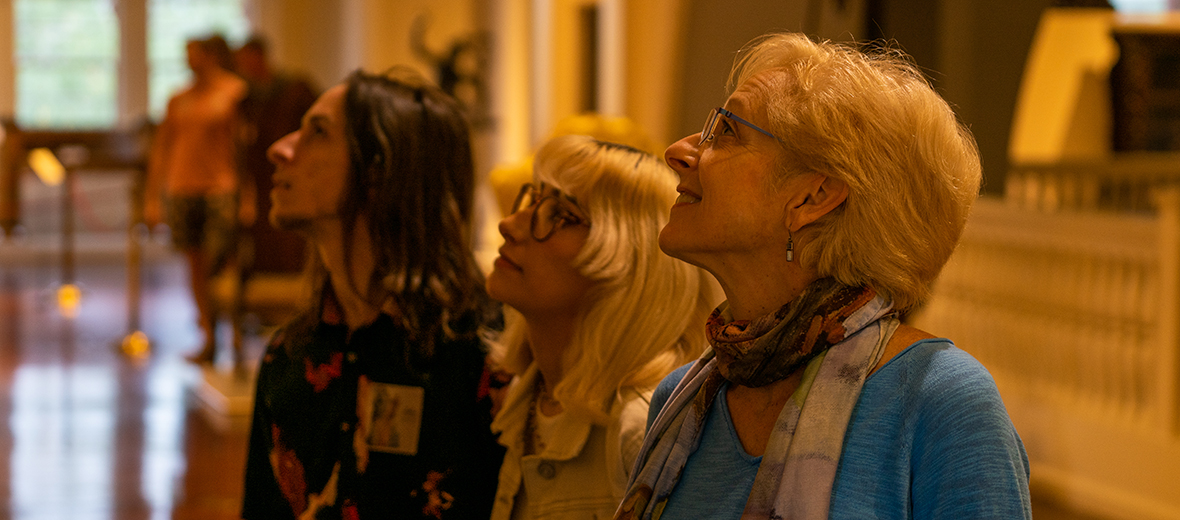Jule is a fun tour guide; this experience feels like a trip to the museum with a friend.
— Harold
Before your tour, build your confidence in how to talk about art by studying the following art terms.
GLOSSARY OF COMMON ART TERMS:
ART HISTORY ERAS
- Common Era/Before Common Era: Common Era is one of the year notations used for the Gregorian calendar, the world’s most widely used calendar era. (Common Era = Christian Era). Before the Common Era is the era before CE. BCE and CE are alternatives to the Dionysian BC and AD notations, respectively.
- Renaissance: Renaissance art is the painting, sculpture, and decorative arts of the period of European history known as the Renaissance, which emerged as a distinct style in Italy in about Common Era 1400, in parallel with developments which occurred in philosophy, literature, music, science, and technology.
- Classicism: is an aesthetic attitude dependent on principles based in the culture, art and literature of ancient Greece and Rome, with the emphasis on form, simplicity, proportion, clarity of structure, perfection, restrained emotion, as well as explicit appeal to the intellect.
- Baroque: arts that flourished in Europe from the early 1600’s until the 1740s. In the territories of the Spanish and Portuguese empires including the Iberian Peninsula it continued, together with new styles, until the first decade of the 19th century. It followed Renaissance art and Mannerism and preceded the Rococo (in the past often referred to as “late Baroque”) and Neoclassical styles. It was encouraged by the Catholic Church as a means to counter the simplicity and austerity of Protestant architecture, art, and music. (from Wikipedia)
- Romanticism: A movement that originated in Europe towards the end of the 18th century, and in most areas was at its peak in the approximate period from 1800 to 1850. Romanticism was characterized by its emphasis on emotion and individualism as well as glorification of all the past and nature, preferring the medieval rather than the classical. It was partly a reaction to the Industrial Revolution, the social and political norms of the Age of Enlightenment, and the scientific rationalization of nature—all components of modernity.
- Impressionism: In the late 1800’s several painters in Paris began to experiment with a looser style of painting that emphasized dabs of paint to create different colors and show light. The paintings were characterized by relatively small, thin, yet visible brush strokes, open composition, emphasis on accurate depiction of light in its changing qualities (often accentuating the effects of the passage of time), ordinary subject matter, unusual visual angles, and inclusion of movement as a crucial element of human perception and experience.
- Post-Impressionism
- Cubism: think Picasso!
- Modernism: (1870-1930’s)
- Surrealism: think Salvador Dali!
- Abstract Expressionism: is a post–World War II art movement in American painting, developed in New York City in the 1940s.[1] It was the first specifically American movement to achieve international influence and put New York at the center of the Western art world, a role formerly filled by Paris. Although the term “abstract expressionism” was first applied to American art in 1946 by the art critic Robert Coates, it had been first used in Germany in 1919 in the magazine Der Sturm, regarding German Expressionism. In the United States, Alfred Barr was the first to use this term in 1929 in relation to works by Wassily Kandinsky.[2]
- Contemporary: Art created from 1960 to today.
STYLES
- Immersive: experiential art
- Figurative: Figurative art describes any form of modern art that retains strong references to the real world and particularly to the human figure.
- Landscape:focus on natural scenery such as mountains, forests, cliffs, trees, beaches, etc.
- Portrait: subject is a person or animal
- Still Life: objects grouped; often the items have significance or double meaning
- Genre paintings: depict a common scene from the time the painting was made
DESCRIPTION of TECHNIQUES or elements to note in a painting
- Painterly: refers to the application of paint in a ‘loose’ or less than controlled manner, resulting in the appearance of visible brushstrokes within the finished painting.
- Chiaroscuro: an effect of contrasted light and shadow created by light falling unevenly or from a particular direction on something.
- Impasto: the process or technique of laying on paint or pigment thickly so that it stands out from a surface
- Perspective: the term perspective refers to the representation of objects in three-dimensional space (i.e. for representing the visible world) on the two-dimensional surface of a picture.
- Figurative: any form of modern art that retains strong references to the real world and particularly to the human figure.
ART MEDIUMS (material)
- Pencil and Charcoal
- Pen and Ink
- Pastels (like chalk or can be oil pastels which are oil crayons)
- Collage (ripped paper, cloth, wax, found objects)
- Encaustic (beeswax and resin) (often on top of collage, painting, drawing or original photographs)
- Paint (types are oil paint, acrylic, or watercolors)
- Gouache-water color with a white powder added, making it more opaque (less see-through)
- Prints (multiple copies off of a printer. (Can be silkscreen, woodblock, etchings, etc.)
- Giclee— A high quality print of a painting, sometimes hand enhanced with touches of paint by the artist. The latest affordable way to acquire art.
- Sculptures (3D art of bronze, stone, metal, wood or found objects
- Photography
Photo by Nick Gatta
 Jule's Art Tours
Jule's Art Tours